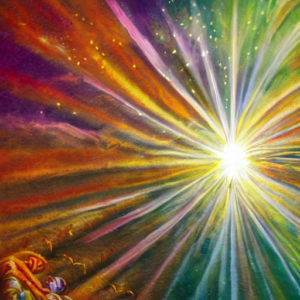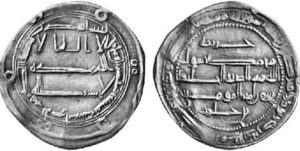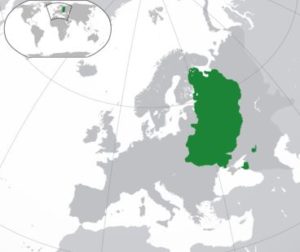 As we tremble and mourn the senseless carnage in Israel over the last several days, we begin a new Torah reading cycle as well. Beresheet opens by telling us that the first thing God created was light. This was a special, divine light which was subsequently hidden away for the World to Come. It is therefore known as the or haganuz, the “hidden” or “concealed” light. The Midrash (Yalkut Shimoni II, 499) states that this light has the power to destroy all evil instantly. For now, it is stored away under God’s Throne, to be revealed only at the End of Days. Unfortunately this means that, at the moment, the world is more like it was before God brought forth this light, when the cosmos was “chaotic and void, with darkness over the face of the abyss” (Genesis 1:2). Indeed, the Midrash teaches that this verse is speaking of the future Four Exiles of the Jewish people: “chaotic” being an allusion to Babylon, “void” to Persia, “darkness” to the Greek, and the “abyss” to the Edomite (Beresheet Rabbah 2:4).
As we tremble and mourn the senseless carnage in Israel over the last several days, we begin a new Torah reading cycle as well. Beresheet opens by telling us that the first thing God created was light. This was a special, divine light which was subsequently hidden away for the World to Come. It is therefore known as the or haganuz, the “hidden” or “concealed” light. The Midrash (Yalkut Shimoni II, 499) states that this light has the power to destroy all evil instantly. For now, it is stored away under God’s Throne, to be revealed only at the End of Days. Unfortunately this means that, at the moment, the world is more like it was before God brought forth this light, when the cosmos was “chaotic and void, with darkness over the face of the abyss” (Genesis 1:2). Indeed, the Midrash teaches that this verse is speaking of the future Four Exiles of the Jewish people: “chaotic” being an allusion to Babylon, “void” to Persia, “darkness” to the Greek, and the “abyss” to the Edomite (Beresheet Rabbah 2:4).
At the same time, our Sages taught that each exile actually has two parts, and is a partnership between two oppressors. (The term “oppression” or “persecution” is probably more accurate than “exile” since, for instance, the Greek oppression happened in the Holy Land and did not involve exile.) Babylon only finished what the Assyrians started in the decades before by destroying the northern Kingdom of Israel and banishing the Lost Tribes. Persia was allied with Media, and the Greek oppression began with Alexander, who was a Macedonian. Similarly, while Edom began the final exile, it is Ishmael who concludes it. This is alluded to in several places in the Torah, including when “Esau went to Ishmael and took for a wife, in addition to the wives he had, Mahalath the daughter of Ishmael.” (Genesis 28:9) The Vilna Gaon taught, in his commentary on Sifra diTzniuta, that in the End of Days, too, the world of Edom will “marry” the world of Ishmael to oppose Israel.
This is precisely what we see today, where Israel’s terrorist Ishmaelite oppressors—Hamas, Islamic Jihad, Hezbollah, and their main financier, Iran, among others—are enabled and supported by Western countries. European nations are quick to condemn Israel and send “aid” to the terrorists. The Western mainstream media constantly paints Israel as the aggressor, and describes the real villains as the poor and oppressed victims. Russia pretends to have good relations with Israel, but keeps Iran as one of its closest allies, arms them, and props up the Iranian regime. It even invited Iran to join its CSTO military defense pact. (Though not currently a full member, Iran is the only non-Soviet nation to be part of the CSTO.) Nor is the United States off the hook since, despite its valuable aid, it has often thrown Israel under the bus. It was George W. Bush’s “roadmap to peace” that pressured Israel to give up Gaza for nothing, and create the huge disaster we are mired in. And it is no coincidence that this current war began just weeks after the Biden administration unfroze $6 billion in Iranian funds, supposedly for “humanitarian” purposes. (Internal memos reveal that the Biden administration was aware the money might go to terrorists, and they proceeded with the deal anyway.)
Make no mistake, nearly the whole world is complicit here in some way. Let’s not forget that the United Nations spends much of its time attacking Israel, and has passed more resolutions against Israel than any other country (than most other countries combined, in fact). Long ago, our Prophets predicted that God would “gather all the nations” against Israel (Zechariah 14:2), and “many nations” would join the wicked Gog against Israel at the End of Days, first among them Persia (Ezekiel 38:5-6). King David foresaw that those who “secretly conspire” against the Jewish people come from both “the tents of Edom and Ishmael” (Psalm 83:7). He goes on to list Moab and Ammon (today’s Jordan), Tyre (ie. Lebanon), Syria, the “Philistines” and, of course, Amalek.
The Torah presents us with 70 root nations in the world, from which all others branch out. These were divided up between “the tents of Edom and Ishmael”, which is why we often see reference not to 70 nations, but to 72 nations. The Vilna Gaon found further proof for this from Psalms 20:8, which says “These [call] on chariots and these [call] on horses, but we call in the name of the Lord, our God.” The word these, eleh (אלה), has a value of 36, alluding to the fact that 36 nations under the umbrella of Edom stand on one side, and 36 nations under the Ishmaelite umbrella stand on the other side. All of this reinforces the notion that the final exile and oppression is an Edom-Ishmael partnership.
Throughout ancient Jewish texts, it is Ishmael who is described as starting the final war in the End of Days. The Midrash (Pirkei d’Rabbi Eliezer 30) says they will launch a three-pronged attack to start the conflict, with an assault in the wilderness, an invasion by sea, and in a “big city”. This is highly reminscent of what we witnessed earlier this week, with terrorists slaughtering helpless young people at a nature party in the wild, landing at the Zikim Beach from the sea, and taking over the city of Sderot, and neighbouring kibbutzim.
Within the wider world of Ishmael—the whole house of Islam—who is it in particular that is the main culprit? Not surprisingly, the Midrash identifies Paras, Iran, as the one that’s really behind the war that “destroys the world” (Yalkut Shimoni II, 499). This is tremendously prescient, since Paras back then was not Muslim, and not yet Ishmaelite. It was only in the 7th and 8th centuries that the Islamization of Persia occurred. And today, Iran is the undisputed leader of Ishmaelite extremism.
Amazingly, the Midrash here says that Iran will do this precisely at a time when the “king of Arabia” will head west for council and diplomacy. Indeed, in recent weeks we saw how Israel and Saudi Arabia were getting closer and closer to a long-awaited peace deal. Iran could not let this happen, and made sure to use their terrorist proxies to attack Israel and axe any such deal. Iranian weapons, training, and funds are behind the deadly massacres we witnessed. Nearly two millennia ago, Rabbi Shimon bar Yochai taught that “when you see the Persian horse tied to the graves of the land of Israel, expect the footsteps of Mashiach.” (Shir haShirim Rabbah 8:9) In other words, when Iranian armaments are causing graves in Israel, the coming of Mashiach is imminent.
The multitude of graves we see today in Israel are beyond tragic, and there are no words to describe the unspeakable crimes committed by the Ishmaelites. While it is no consolation whatsoever, this terror was foreseen, and the Midrash even states that God deeply “regrets” having created four things, foremost among them is Ishmael (Yalkut Shimoni II, 424). The Talmud describes some of these Ishmaelites as se’irim shel beit hakis’e, like “demons of an outhouse” (Kiddushin 72a). We certainly saw such demonic beings in the grotesque crimes committed against innocent civilians, helpless youths, and little children—may Hashem avenge their blood.
Foreseeing these tragedies, the Sages declared: “Let [Mashiach] come but let me not see him!” They would rather not be alive to witness such things. The same Midrash cited above (Yalkut Shimoni II, 499) says the Jewish people will be so confounded at the End of Days that they will repeat over and over again l’eikhan navo v’nelekh? “Where do we go from here?” But God will reveal Himself soon after, and restore the primordial light of Creation—that hidden or ha’ganuz first mentioned at the start of this week’s parasha. We will bask in this light, glow with it, illuminate the whole world, and finally enjoy the era of peace and prosperity we’ve been awaiting for so long.
May we merit to see it very soon.



